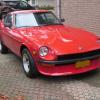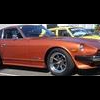The P.A.P. is interesting. The thick ink is typical of the salvage yards paint pen. I wouldn't be surprised if the car has had the dying problem for years, causing it to get moved on to owner after owner. The problem is almost like a module problem but not quite, as EuroDat says. Easy to get misdirected. Based on the whole story and all of the work that was done to get it tuned right, and the fact that it does run well when it runs, but it still dies randomly, if it was my car and I had a spare ECU to try that's what I'd do next. The problem-solving path followed isn't exactly the factory path but that is Nissan's last resort - replace ECU. Next time it dies, if your left leg is flexible enough, kick the kick panel that the ECU is hiding behind and see if that gets it going again. People have said that whatever loses connection in the ECU can be be "fixed" by beating/tapping/kicking the ECU. Won't hurt it, the electronics inside are not today's super-tiny sensitive type, they're big clunky pieces.






